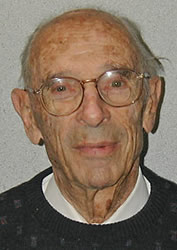

|

|
IN MEMORIAM
Heinz Heinemann
Lecturer in Chemical Engineering
UC Berkeley
1913 – 2005
Dr. Heinz Heinemann passed away on November 23, 2005, at the age of 92. Throughout his life his seminal work resulted in significant gains in the fields of chemistry and chemical engineering. He will be long remembered as a distinguished scientist and a leader in the development of catalytic technologies.
Born in Berlin, Germany, in 1913, he attended the university and the Technische Hochschule in Berlin. When his thesis was rejected because he was Jewish, he moved to Basel, Switzerland, where he received the Ph.D. in physical chemistry from the University of Basel. In 1938 he came to the United States to begin his professional career. From 1941 to 1948 he was a research supervisor for Attapulgus Clay Company. In 1948 he joined the Houdry Process Corporation as a section manager in their research department, and in 1957 he joined the W. M. Kellogg Company, first as assistant to the vice president of research and later as director of chemical and engineering research. From 1969 until 1978 he was affiliated with Mobil Research and Development Corporation and was manager of catalysis research in their Princeton laboratory.
Upon his retirement from Mobil in 1978, he became a senior scientist at the Lawrence Berkeley National Laboratory, where he continued to pursue research on new catalytic processes for the production of gaseous and liquid fuels from coal and later from natural gas. He began by working with graphite as a model carbon solid to study the catalytic gasification using potassium hydroxide as a catalyst. He found that at the relatively low temperature of 500oC, hydrocarbons from C1 to C6 could be formed with high efficiency. He worked on the mechanism and discovered that the carbon bond next to the O-K bond of potassium hydroxide had to be broken as the rate-limiting step to produce products of CO and hydrocarbons. Following the work with graphite as a model catalyst, he studied the steam gasification with chars at temperatures below 700oC using a potassium oxide-calcium oxide catalyst, which shows superior resistance to deactivation by sulfur. In 1989 and 1990, Heinemann turned to the oxydehydrogenation of methane using catalysts such as calcium, nickel or potassium oxides at temperatures below 600°C, a theme that he pursued for the remainder of his years at Berkeley. When he retired from his position as senior scientist in 1995, he continued working as a distinguished scientist in the Washington, D.C., office of the Lawrence Berkeley National Laboratory, serving as a liaison between the laboratory and the U.S. Department of Energy.
During the course of his career, which spanned more than 60 years, he participated in the invention and development of 14 commercial processes, including the process for converting methanol to gasoline, received 75 patents, and published more than 150 papers. He was a cofounder of the Philadelphia Catalysis Club, the Catalysis Society of North America, and the International Congress on Catalysis, serving as its president from 1956 to 1960. In addition to serving as the editor of Catalysis Reviews for its first 16 years, he was consulting editor for over 90 books in the Chemical Industries Series, published by Marcel Dekker, Inc., many of which dealt with catalysis.
In a way, Heinz Heineman was bigger than life since he played such a major role in the history of American catalysis science. His contributions to the science and industrial practice of catalysis were widely recognized. He was a member of the National Academy of Engineering and received the E. V. Murphree Award in Industrial Engineering Chemistry of the American Chemical Society; the E. J. Houdry Award in Applied Catalysis of the Catalysis Society; the Homer H. Lowry Award in Fossil Energy given by the U.S. Department of Energy; a Distinguished Scientist Award of the Department of Energy; a Distinguished Lectureship Award of the American Institute of Chemical Engineers; the Philadelphia Catalysis Club Award; and honorary membership in the Spanish Research Council with the title of honorary professor.
He is survived by his wife of 10 years, Barbara A. Tenenbaum of Washington, D.C., and two children from his first marriage — Sue Heinemann of Oakland, California, and Peter M. Heinemann of San Francisco. Dr. Heinemann’s first wife, Elaine P. Heinemann, died in 1993.
Gabor A. Somorjai
Alexis T. Bell